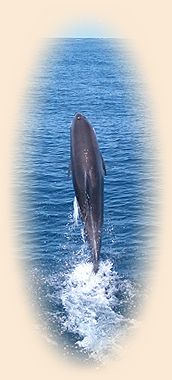 Costa Rica, the second time around, really hit
the spot in a winter that seemed to have no end.
Playing with beautiful sailfish, floating amidst
sleeping whales and having a thousand spinner
dolphins escorting our boat were just some of
the beauties of this trip. Living in a perfectly
run lodge, eating wonderful meals and fishing from
great boats with expertly trained crews rounded out
this trip to Crocodile Bay Resort in the southwest
corner of Costa Rica. What a difference a year
makes.
Costa Rica, the second time around, really hit
the spot in a winter that seemed to have no end.
Playing with beautiful sailfish, floating amidst
sleeping whales and having a thousand spinner
dolphins escorting our boat were just some of
the beauties of this trip. Living in a perfectly
run lodge, eating wonderful meals and fishing from
great boats with expertly trained crews rounded out
this trip to Crocodile Bay Resort in the southwest
corner of Costa Rica. What a difference a year
makes.
This Febuary trip was taken last year by mostly the
same team of fishermen with El Nino affecting
everything on the water as well as casting a pall
on the shore activity because of lack of fishing.
The camp leadership actually gave us a free day
this year because of the abnormal conditions we
had in what was supposed to be the best time of
the year last year. I am really glad we took up
the offer. I recommend this lodge to anybody,
especially families, as besides the fishing the
eco touring, ATV riding through the jungle, and
kayaking in the bay are just some of the "other"
things to do besides fishing some of the most
beautiful calm water the Pacific Ocean offers.
The trip started with all six of the travelers
escaping the North American winter to join in San
Jose, the capital of Costa Rica. We spent the
afternoon and night telling fishing lies and
sitting beside the pool enjoying the beautiful
75 degree day and a parade of pretty bodies
wearing tiny bathing suits. It was an early
night as "get-up" time for the bus to the commuter
place was around 0445. Some of us were so hyped
up about the fishing sleep was difficult. We took
the hour-long small plane ride dropping us off a
half mile from the lodge and we were on the boats
by 0830 after a fine breakfast. There was an hour
forty-five minute ride to blue water and the first
fish on our boat was on camera by about 1130.
Hooking and catching these beauties on flies is not
a slam-dunk like trolling seems to be (Another guy
at the lodge caught seven in one day trolling and
his wife got one too). It takes a coordinated effort
and some skill on the part of the crew and fishermen
to get the fish up close enough and then switch from
what was used to get them interested to something
with a hook in it. Then the fish has to be convinced
to bite the new input to the game followed by getting
the hook set and then clearing the line for the initial
run. Then come the jumps and not losing the hook-up
during one of those. Next comes getting the fish back
to the boat and finally close enough for the mate to
grab him. Pulling the beast over the side for a
picture and then releasing completes the feat.
Sailfishing 101, hooking the fish:
Some folks might say the 101 course would be being
able to not leak warm fluid down your leg with a 140
pound fish thrashing about 20 feet way on the surface
while you calmly try to cast an oversized fly with a
much too heavy fly rod. I will skip that and start
with getting the fish to the boat and hooking it.
To do any of this you have to have fish show up
behind the boat. Last year that was a problem.
This year we had about 15 to 20 shots a day at
fish and several times multiple fish showed up,
sometimes all three teasers where being thrashed
at the same time or in quick sequence.
The first part, "teasing" the fish up, starts by
trolling three of these hookless baits staggered
from fifty to a hundred feet behind the boat
which is moving at about six to eight knots. You
can easily see the fish nose, fin or black shape
when one starts attacking one of the baits. At
least one of the non-attacked teasers is yanked
in while the one the fish is behind is pulled up
behind the boat, which is slowed to keep the bait
seem like it did not. When it is close enough,
about 20 to 30 feet back and attacking the teaser
and the fisherman ready to cast, the boat comes
out of gear, the teaser is pulled quickly out of
the water while the fly is landed, hopefully, off
to the side of the fish so he can see it. It is
probably supposed to be like the food he was
targeting jumped and landed again. The "new" food
is popped once and then let drift. The pop may be
repeated if the fish does not see it and turn that
way. When the fish turns toward the fly and attacks
it is hopefully at a ninety-degree angle or more
from the direction of the fly line. This gets
the hooks at an angle to catch in the upper part
of the sword and also gives you a chance to set
the hook on a fish from behind the 3 or 9 O-clock
line of the fishes body. If all this works, you
are off to the races with one of the jumping
champions of the world of fish.
There are a couple of failure modes to the SF 101
course. First the fish might not be totally
interested and just watch for a bit and leave. You
can tell if he "lights up" showing his colors and
tries to beat the teaser to death with the long sword.
Next the fish can switch teasers and cause lots of
action on the back of the boat with folks thrashing
about trying to get the right person doing the right
things to affect a hooking event. The cast comes
into play and needs to be done correctly the first
time or the fish will not see it or lose interest
when time lapses for a recast. While the fish is
being teased up the caster has his fly in the water
at about fifteen feet back to use the water to "load"
up for a back cast. That tug and back cast is usually
up wind because of the boat movement and waiting for
the line to roll out backward is difficult as you are
always in a rush with the warm fluid just under control.
The cast needs only be about 30 foot maximum and in one
case only five. It is good we saw so many fish as even
as experienced as we all were, casts were blown and fish
confused resulting in disappointment all around, even
the fish, who thought he was going to eat something.
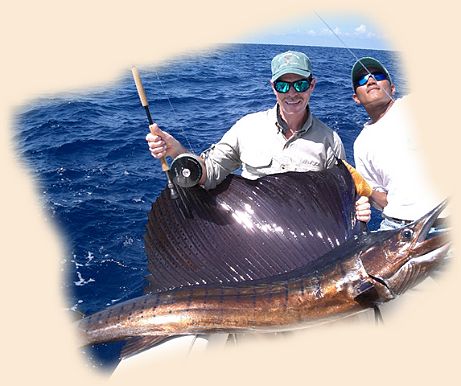
It is not always easy to hook these guys and we had
more not get hooked than did at first. The primary
problem was having the fish fall in behind the fly
and just thrash at it with the beak and take bites.
The hook up attempts keep pulling the fly out without
a hook catching. Even with letting the fly free to
drift does not get the fish to turn and bite it going
away. The need to pick the fly up quickly and then
drop it off to the side is about the best recovery,
but the fish can get pissed and leave if too much
time lapses between food sightings.
Sailfishing 102, fighting the fish:
With the fish hooked and running away it is only
a matter of time before the jumps began. If you
drag is tight (three to four pounds for a 20 pound
leader) you might get him airborne right behind
the boat. If he runs out a less tight drag, and
four pounds is a lot to hold, he may make a hundred
yards before trying to fly. At any rate, when the
fish goes up you need to "bow" to lessen the chance
of the hook coming out of the hard mouth. Bow means
to slacken the line some how. You can point the
rod at him and give him line or, as our fearless
leader, Ted Johnston, does point at the fish with
the rod and lunge, as in fencing, toward the line
direction. You have to do it down the line as
that offers more relief and the fish can be jumping
90 degrees off to the direction of the line pull.
It has not caught up from an off angle run.
The first one I watched caught jumped 26 times
during a 25-minute fight. That was the longest
fight any of us had and Steve, the guide of 202-pound
tarpon fame, wanted to be sure he got that one to
the boat. He tightened up on the next one and had
him in and released in less than seven minutes. I
had a fish jump well over 30 times and spend so
much time out of the water it needed SPF 30 lotion.
Most of the fights lasted 10 to 12 minutes at most
and often smaller fish where in and back swimming
in about 7 to 8 minutes.
Anyway, the fight and jumping is kept off the back
of the boat by the skipper keeping the boat aligned
and then when the after jump pulling starts he
"backs" the boat down toward the fish to help you
reel up the line and get the fly line back on the
reel. This stops the backing from cutting your
fingers and allows backing off the drag some and
using hand/finger pressure to be used as drag.
Failure modes abound in SF 102 also. The hook coming
out of the mouth happens even with good bows. These
are not easy fish to hook but not as hard as a tarpon.
Equipment failure causes break offs. If you have a
leader, line, knot or backing problem it will be
highlighted in this phase as it is a dynamic series
of tugging and slacking in 102. I personally had
line, leader and knot break offs and that may have
been the most of anybody. I learned the value of
fishing with new line every trip changing leaders
between fish and testing every leader and knot after
tying. The leaders we used where the same ones used
for tarpon, 20-pound Bimini twist tied class sections
with an 80 or 100 pound bite tippet. Add that to a
short butt section for an over all length of seven
feet and you are in business for these fish that
ran in the 85 to 140-pound range.
Sailfishing 103, landing the fish:
This after-jump phase consists of the fish going
down and just pulling to get away from the boat.
You just put the pressure on and pump and reel to
get him up to the boat. The skipper is constantly
adjusting the boat to keep the fish off one corner
of the stern so eventually the mate can get a grip
on the sword. The mate gets hold of the stronger
part of the leader and gently pulls the fish the
final couple of feet up and grabs the sword. The
fish goes crazy about then and the mate holds on
for a short period of thrashing before either
unhooking and releasing or pulling it over the
side into the fisherman's lap for a picture.
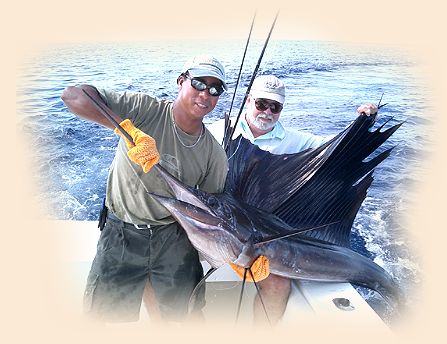
The only failure I saw during this phase was mine
and the fish was still landed. (That's one of mine
above) I had a 12-weight rod snap during the landing
of the fish. The guide grabbed the leader and
the fish did not know the difference. I was the
only one fishing with a nine-foot 12-weight and
probably should not have with a fish that had
the option to go deep. It was a new rod offered
to us to try and try I did. It could have been
my technique but knowledgeable observers did not
see any particularity blatant flaw in what I did.
I changed to an eight and a half foot 13-weight
for the rest of the trip.
Several used 14-weight rods and one had his 15
in service most of the time. He might have been
the only one who could have handled a marlin if
it had attacked. The rest of us would have watched
it jump and break off probably. They run considerably
larger and are not pussycats like the sailfish are.
Side Lights:
A couple of high lights on this trip occurred to
me and to our three-man team. We used two boats,
a 33 Strike and a 35 Strike. These are the biggest
of the lodge's fleet and very good boats for this
mission. After the second day the A33 team challenged
the A35, - us, to a contest for the most fish jumped
or landed. All you had to do was get two jumps and
then you could avoid the rest of the fight if you
wanted and break them off. Some wimp did not want
to go through the SF 103 thing of pulling. Rum
flowed and the bet went from $100 a man to a shirt
of the loser's choice then settled on a specific
shirt of the winner's choice. There is a nice gift
shop in the lodge with many shirts. One of the
options might have seen the winners in some pink
woman's halter.
The day came and went and neither team had a big
day but the A33 boys had a last minute change of
captain and mate which cost them the super team
they started out with. We won and the shirts
were argued over for many beers before we ended
up with pinkish/yellow logo shirts of great worth.
Another bet got started but the lawyers in the fight
prevented finalization in the remaining eight hours
before the final day launches.
Special Fights:
One special fight happened to me on day three. I
hooked a nice fish as it was my turn when several
fish showed up in the teasers. When this one took
off after hooking and during the jumping the captain
restarted the teaser dragging to let Ted, the next
up get hooked up. The distance between the boat
and my fish increased greatly while this when on.
Ted did not get this fish as confusion was at high
ebb. My fish jumped five times and came off (making
it a "for shirt" counter). While I reeled in from
about two hundred yards the boat set up the three-teaser
drag. It was not easy to get the fly in as it has
a four square inch flat popper nose. Another fish
took my fly while about 200 feet back on the retrieve
but I could not get the attention of anybody as there
were fish in the teasers and again and that show was
exploding all around me. This fish jumped once and
got off (a non-shirt counter). I did not have a chance
to set it well.
Ted was in a recast mode with a fish at about 30
feet back when I finally got my fly into that range
on a rapid pace to clear the decks of my act. Ted's
fish was not going for his fly and turned on mine.
What was a guy to do? I just released mine to float
back and the fish took a going away shot and hooked up.
This one I landed after a seven-minute fight. I gladly
sat down after the hat trick only to have Ted announce,
"that was technically my fish." The discussion was about
me missing a turn next time around and I didn't really
care but claimed victim status so as not seem unmanly.
A second notable fight happened the last day. Unk
had two fish already landed and was up again. I had
one in by then and Ted also had one. I, once again,
had a fish take me well into the backing and jump
a dozen times before coming unbuttoned for some
reason other than a break-off. The boat started
up on the troll again while I reeled in as quickly
as I could. Unk was up to bat. When my fly was 30
feet back from the rear teaser we could see a big
fish was following this special fly, not pink like
all the other we were using. The other teasers
were pulled out of the water so I could hook the
fish. A quick discussion erupted behind me about
who this fish belonged to. I didn't want my other
partner complaining about "technical" fish. Instead
of either releasing the fly for a bite or recasting
for one I reeled too fast for the fish to bite and
told Unk to cast. I pulled my "teaser" out and Unk
landed his third fish of the day. The was no mention
of my sacrifice at all for some reason. Getting
multiple hook-ups per cast did not impress my partners.
The last tail of the fishing was the last battle
of the day. Unk did not take himself out of the
line up but I did get up again. Once again multiple
fish jumped the teasers and I hooked up first cast
leaving a second fish beating the fire out of the
back teaser. Ted picked up a rod and tossed a
perfect shot and hooked up the second fish. The
individual fights kept apart completely like it
was planned and both got landed in short order.
The best part of this was the other boat was nearby
and got to watch both fish jumping at the same time.
They had a couple of fish for the day but our nine
counters made their day seem puny. The lawyers did
them a favor in not closing the bet.
Nature touring:
Just a short note is needed to close this out.
Nature was abundant for us on the water. Not only
were the seas calm every day and a deep blue that
makes you feel like you are flying instead of floating,
but it was full of things other than the fish we chased.
On three days we ran into whales, sometimes in pods of
forty plus. Once these pilot and pigmy pilot whales
were sound asleep allowing us to idle right into the
middle of them waking them up so they could slowly
move away and go back to sleep.
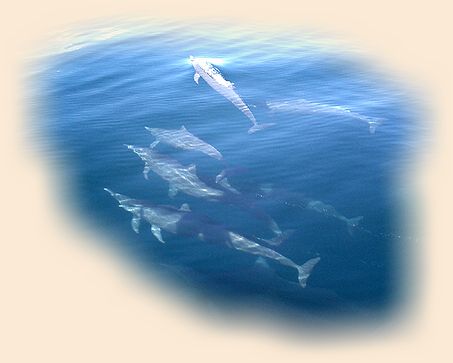
On the hour and a half ride to fish the last day we
drove into and along with a pod of spinner dolphins
that must have had over a thousand members. They
surrounded the boat and just sort of bounced out of
the water doing triple twists. They were jumping on
all sides and back and front. The pod was a couple
hundred yards across. You leave them and you jaws
hurt from smiling so hard.
The bigger porpoises were around with the spinners
and also among the whales. These guys, about 800
pounds each, would surround the boat too but in
lesser numbers and a bunch of them would ride just
under the nose of the boat riding the bow wave.
One in particular had a long ride and we could
look down over the nose and see he had a couple
of remora type fish hooked on his sides. These
where not the normal black and white remoras but
parrot fish blue.
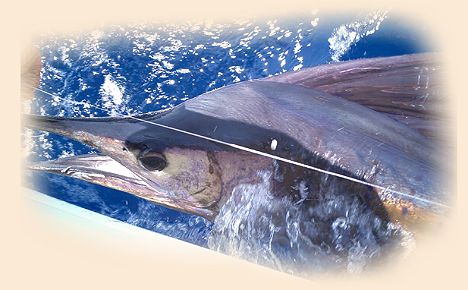
When Unk and I both were staring down at this array,
the animal made sure we were both looking by shifting
sides and then raced out in front and jumped up in
front of us at about 30 feet out in front of boat.
He did this several times and I even got a picture
of the act so close that I got splashed. The little
clinging fish where several pounds each and would
shift position in the air to hide from the landing
forces. We argued about why the animal would allow
these to hang onto him and wondered if the jumping
was to get rid of them. I think they were probably
a porpoise version of a box lunch.
There was more about the trip but I promised to keep
this down to less than ten pages. With pictures I will
be over again, sorry.
https://www.crocodilebaylodge.php gets
you to the lodge page to see what it all about and
https://leisuretimetravel.com/ takes you to Ted Johnston
who will set you up with a trip with the best deal
possible. Ted has been working with them for years
and can make sure you are fully prepared to make a
trip with the best possible chance of success.
~ Capt. Scud, Feb., 2004
|











